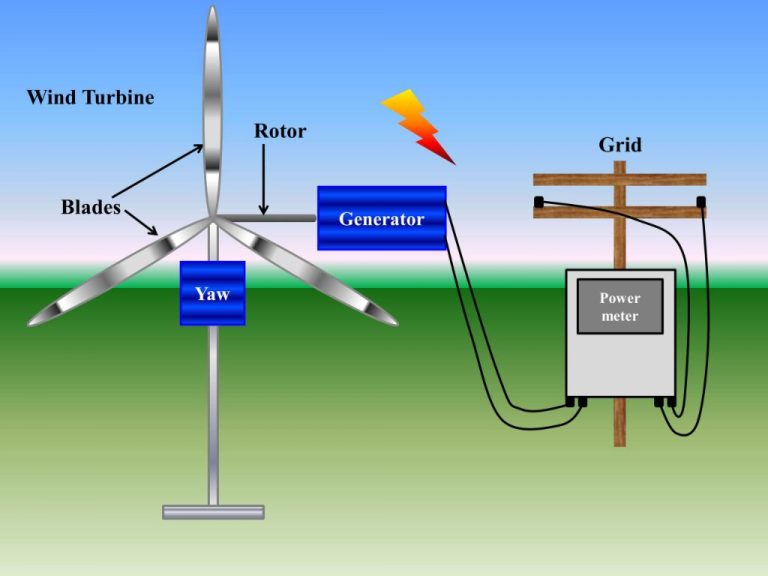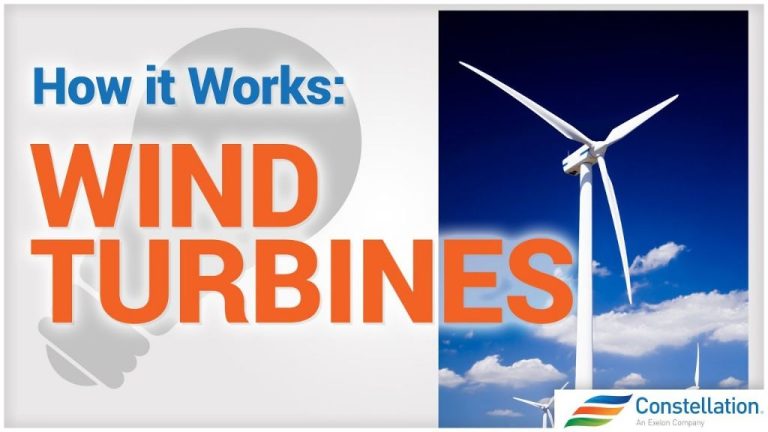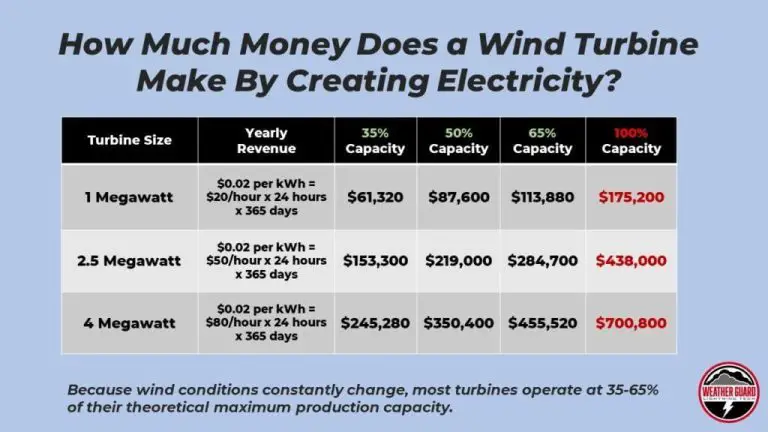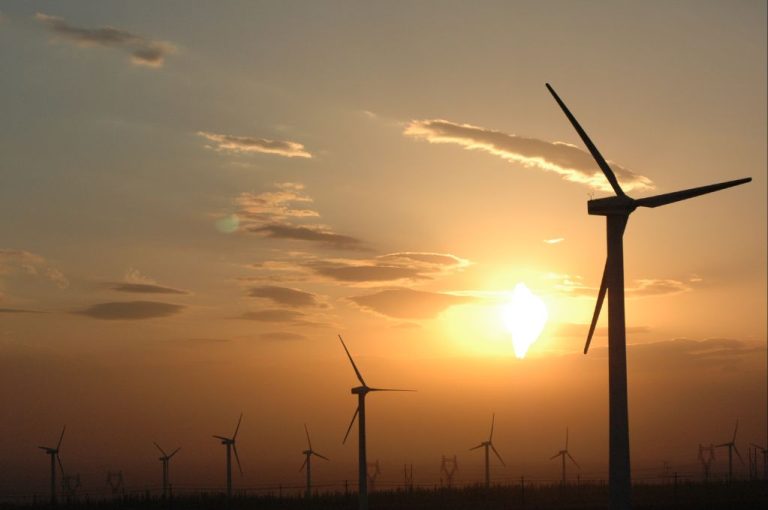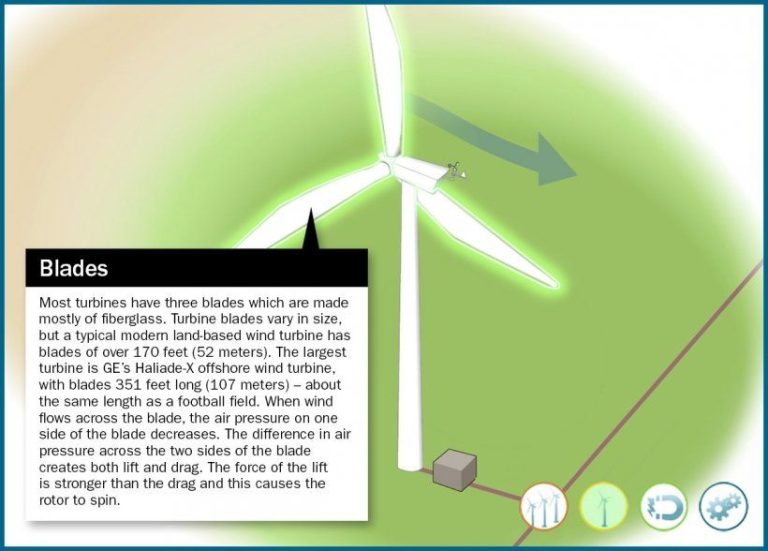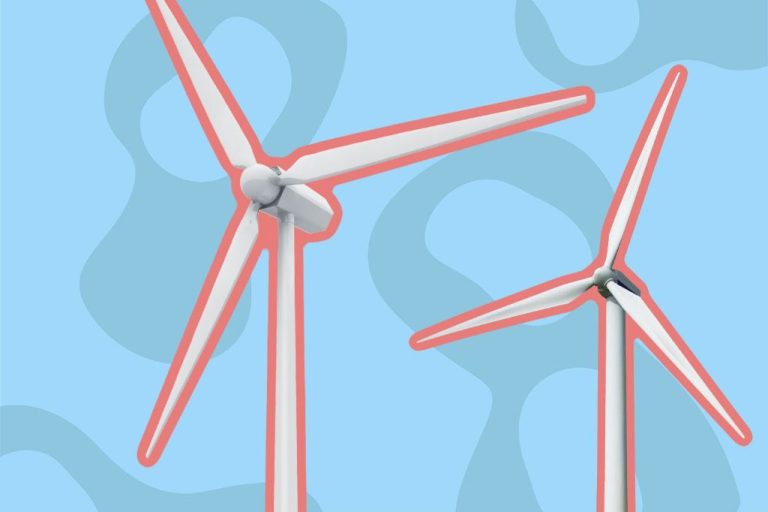How Many Wind Turbines Can Be Put On An Acre Of Land?
Wind power is an increasingly important source of renewable energy around the world. In recent years, the amount of wind power capacity installed globally has accelerated rapidly, largely due to government incentives and advances in wind turbine technology. Statistics show that global installed capacity grew from 17 gigawatts (GW) in 2000 to over 120 GW by the end of 2010 (RenewableUK). This growth is expected to continue as more countries work to shift their energy mix toward renewables. According to the Global Wind Energy Council, wind power could provide up to 20% of global electricity by 2030.
Wind Turbine Sizes
The size of wind turbines can vary greatly depending on their intended use and location. Utility-scale wind turbines that feed into the electricity grid are generally much larger than small wind turbines used for residential or commercial sites. According to Lambdageeks.com, many commercial utility-scale wind turbines have power ratings between 1 and 3 megawatts (MW), and newer turbines are trending even larger at 5-10 MW.
The largest wind turbines today can have tower heights over 300 feet, rotor diameters over 500 feet, and generate over 10 MW of power. The Lambdageeks report states the average utility-scale onshore turbine in the U.S. stands about 300 feet tall with a rotor diameter of 300 feet. Offshore turbines are often larger, such as the Haliade-X prototype from GE Renewable Energy which stands 853 feet tall and has a rotor 754 feet in diameter.
In contrast, small wind turbines used for homes, farms, and small businesses are much smaller in scale. According to the Department of Energy, small wind turbines can range from 20-100 feet in height with rotors 6-23 feet in diameter and generate from 400 watts to 100 kilowatts of power. The size depends on the intended use and available wind resource.
Turbine Spacing
The recommended spacing between wind turbines is typically 6-10 rotor diameters in the crosswind direction and 3-5 rotor diameters in the downwind direction. This allows enough space for the wakes behind each turbine to disperse before reaching the next turbine (Hiester, 1981).
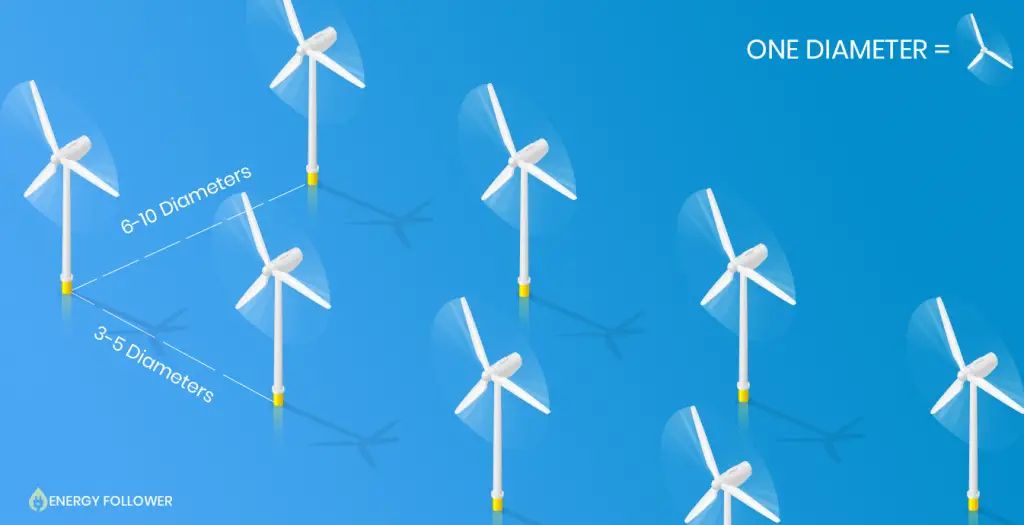
Some key factors that affect turbine spacing include:
- Wind conditions – More turbulent winds require wider spacing
- Rotor size – Larger rotors need more space between turbines
- Wind direction – Spacing is wider perpendicular to the prevailing wind
- Wake effects – Wider spacing reduces turbine interference
- Efficiency vs. cost – Closer spacing allows more turbines but reduces output
Optimizing turbine spacing involves tradeoffs between efficiency, cost, and land use. More compact spacing can lower project costs but results in greater wake turbulence and energy losses (Hiester, 1981).
Turbine Density
The average number of wind turbines per acre can vary greatly depending on the size and spacing of the turbines. According to one source, modern wind farms generally have 1-3 megawatt turbines spaced 3-10 rotor diameters apart (Reddit). This allows for roughly 3-5 turbines per acre for smaller 1-2 megawatt turbines, and 1-2 turbines per acre for larger 2-3 megawatt turbines.
The highest onshore wind turbine densities tend to be around 5-7 turbines per acre with smaller turbine sizes under 2 megawatts. For example, one study found average densities ranging from 5-7 turbines per acre in several European wind farms using 850 kW and 1.3 MW turbines (Middleburg Heights, Ohio). Offshore wind farms can achieve even higher densities with smaller turbine sizes.
However, as turbine sizes continue to increase to 2-3 MW and above, the densities typically decrease to 1-3 turbines per acre to allow for sufficient turbine spacing.
Capacity Factors
The capacity factor of a wind turbine or wind farm describes how much electricity it generates over a period of time compared to its potential maximum output if it operated at full capacity non-stop. It is expressed as a percentage of the theoretical maximum output.
For example, a wind turbine with a capacity of 1 megawatt (MW) that generates 2,190 megawatt-hours (MWh) of electricity over the course of a year would have a capacity factor of 25% (2,190 MWh / (1 MW x 8,760 hours in a year) = 0.25). The average capacity factor for land-based wind turbines globally is around 25-30% (https://energynumbers.info/capacity-factor-of-wind).
Offshore wind turbines tend to achieve higher capacity factors of 30-50% due to stronger and more consistent wind speeds over water. Theoretical maximum capacity factors can reach 59-60% before wakes between turbines start to reduce efficiency (https://www.windpowermonthly.com/article/1163492/gaining-better-understanding-capacity-factor-productivity-efficiency).
Power Output
The power output of a wind turbine depends primarily on the swept area of the rotor blades and the wind speed. Larger turbines are able to capture more wind energy and therefore produce more power. According to the Small Wind Guidebook from the Department of Energy, a 100 kW turbine has a rotor diameter of around 23 meters, while a 1.5 MW turbine has a rotor diameter around 70-80 meters (WINDExchange, n.d.). This increased swept area allows modern multi-megawatt turbines to generate 100 times more power than older 100 kW turbines.
At a typical wind farm density of about 5 MW per acre, you could have around 3 large 1.5-2 MW turbines on each acre. Assuming a 35% capacity factor (the percentage of actual power output over the year versus maximum possible output), each turbine would produce around 4.5-6 GWh annually. Therefore, 3 turbines per acre would generate 13.5-18 GWh per acre per year. More turbines could fit on each acre but spacing and efficiency would decrease. Ultra-high density turbine configurations are being researched to maximize power production per land area.
Efficiency vs. Spacing
There are tradeoffs between wind turbine density and overall efficiency that developers must consider. According to the U.S. Department of Energy, turbines placed upstream or downstream of one another should be at least seven rotor diameters apart (Source). This spacing allows airflows between turbines to recover and reduces any turbulence effects from the upstream turbine. Having turbines too close together can result in lower energy production due to these interference effects.
However, wider spacing also results in fewer turbines able to be installed on a given plot of land. Developers must optimize between efficiency and density based on factors such as prevailing wind directions, land constraints, turbine models, and financial goals (Source). Typical industry guidelines recommend crosswind spacing of 2-4 rotor diameters and downwind spacing over 7 diameters. Advanced software modeling can also help determine optimal layouts. The most efficient spacing balances maximizing individual turbine output with the total energy yield across the entire wind farm.
Location Factors
The geography of a location impacts the spacing of wind turbines. Things like terrain, prevailing wind patterns, access roads, and transmission infrastructure must be considered. Offshore wind farms allow for tighter turbine spacing since there are fewer physical constraints. Onshore sites often have more limitations in terms of terrain, existing infrastructure, and land accessibility.
According to a study by Mentis, optimal spacing for onshore wind farms is about 5 rotor diameters between turbines. However, offshore wind farms can achieve higher density with 3-4 rotor diameters spacing. The study found that onshore wind farms averaged about 5 MW per km2 while offshore wind farms averaged around 8-9 MW per km2 capacity density (Mentis, 2013).
So the location and characteristics of the site have a significant impact on turbine spacing. More constraints onshore necessitate greater spacing between turbines.
Financial Considerations
Two major financial considerations for wind farms are land leasing costs and installation/maintenance costs. According to a recent article, the average land leasing cost for wind turbines is $1,000 – $6,000 per acre in the United States (https://finmodelslab.com/blogs/startup-costs/wind-farm-startup-costs). Landowners can receive annual rental payments of up to $8,000 per turbine (https://www.landmarkdividend.com/wind-turbine-lease-rates-2/). So leasing rates are an important factor when evaluating turbine spacing and density.
Installation costs vary greatly based on turbine size and location factors, but often range from $1.3 million to $2.2 million per megawatt of capacity (https://finmodelslab.com/blogs/startup-costs/wind-farm-startup-costs). Ongoing maintenance costs are estimated at $10,000 – $15,000 per turbine per year. So optimizing spacing to maximize electricity production while minimizing installation and maintenance costs is crucial for wind farm profitability.
Conclusion
In summary, the key factors that determine how many wind turbines can be put on an acre of land are the size of the turbines, the spacing between them, the capacity factor, and the geographic location. Modern commercial-scale turbines are very large, often 2-4 MW capacity each. These massive turbines require substantial spacing between them for safety and efficiency – usually 3-10 rotor diameters apart. Given the size of the rotors, this means that each turbine needs about 1-5 acres. Factoring in roads and infrastructure, wind farms usually need a minimum of 30-50 acres per turbine. The capacity factor also reduces the realized power density per acre significantly below the peak turbine rating. Optimal wind farm locations have capacity factors of 30-40%. So a 2 MW turbine will average 0.6-0.8 MW. Finally, geographic factors like wind speed, permitting, regulations, and land costs impact the economic viability. In most cases, wind farms place 1-3 turbines per 40-100 acres. While the power density per acre may seem low compared to other energy sources, wind energy can utilize land that remains productive for farming or grazing. Overall, modern wind turbines require substantial land areas to operate efficiently, but can coexist with other compatible uses.
In conclusion, while wind power is renewable and emits no greenhouse gases, wind turbines require much more land area per megawatt than traditional power plants. Careful planning and siting is necessary to balance productivity, spacing, environment impact and costs. With their large footprints, wind turbines are usually spaced over dozens or hundreds of acres of open land. But if sited appropriately, they can share land with agricultural uses like farming or ranching. Though 1-2 turbines per acre is physically possible, most wind developments opt for much lower densities to maximize performance and economics.

